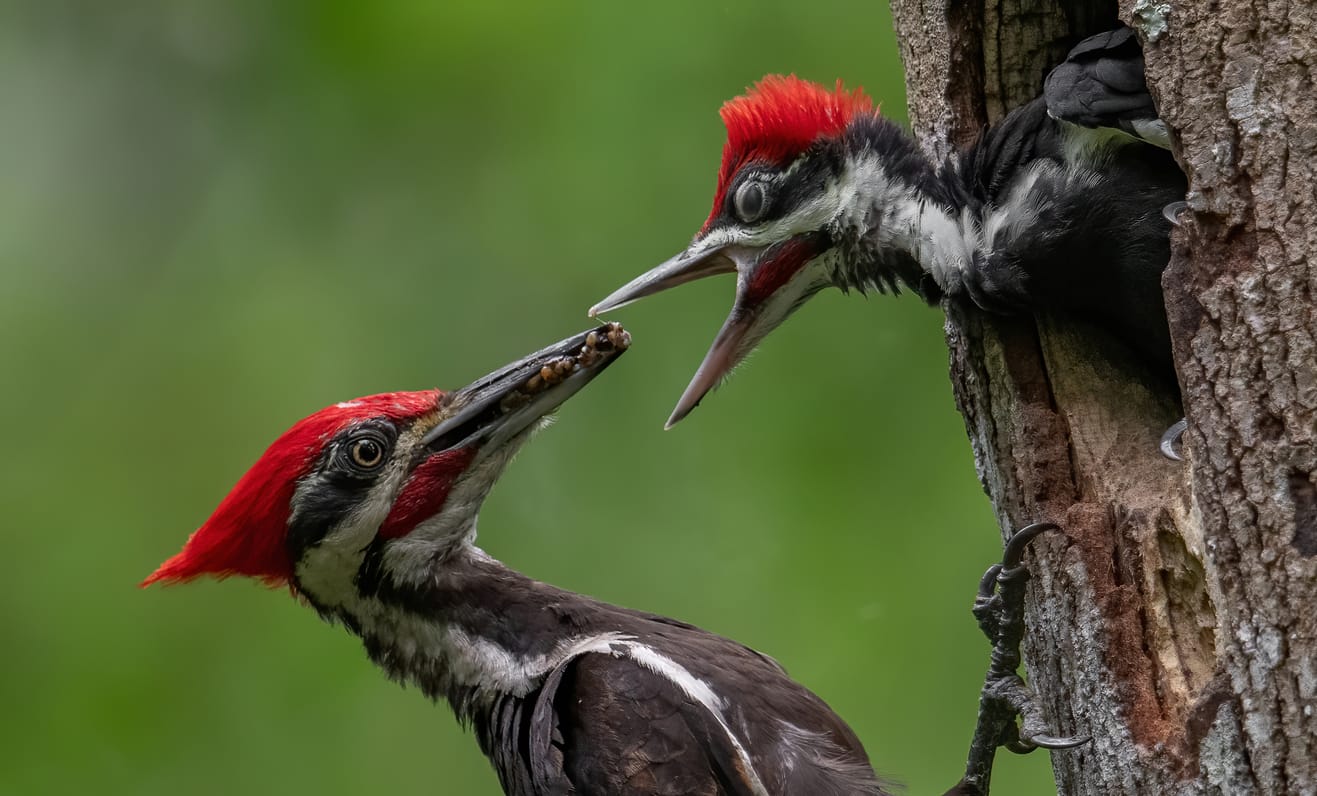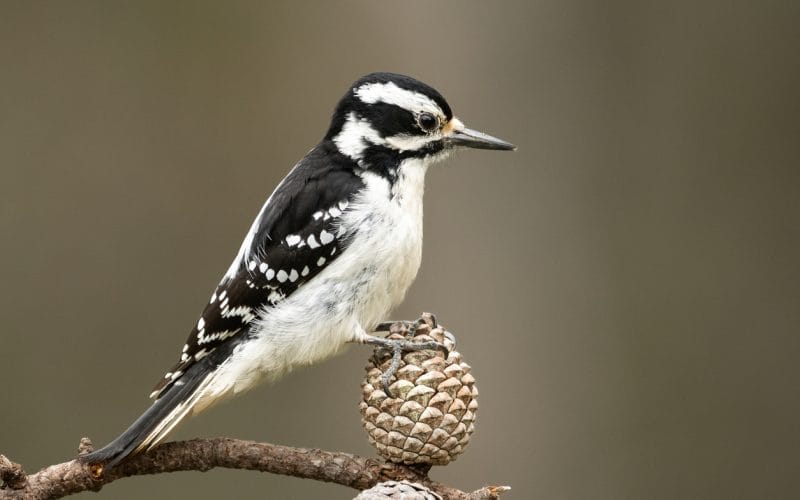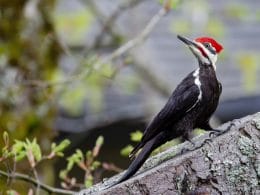Did you know that woodpeckers sometimes like to make music? Their pecking isn’t always in search of food. In fact, most of the time it’s either for communication or asserting dominance.
When woodpeckers like to communicate, they start using certain patterns of drumming instead of their constant drilling. Those patterns may not help you identify the bird itself, but you can definitely tell that there’s a woodpecker nearby.
If you live in Illinois, there’s a good chance you may have already seen a few woodpeckers. Should you want to know more about woodpeckers in Illinois, this easy-to-read guide is for you.
1. Pileated Woodpecker

- Scientific name: Dryocopus Pileatus
- Length: 15.8-19.3 inches
- Weight: 8.8-12.3 ounces
- Wingspan: 26.0-29.5 inches
Let’s kick off our list with a woodpecker that’s as big as a crow! The Pileated Woodpecker is easily one of the biggest birds in North America.
Pileated Woodpeckers are mostly black with some white on their necks. The most iconic feature is the gorgeous red crest on their heads. You can tell the male from the female by the red patch found on the cheeks of males.
Author Note: Pileated Woodpeckers can be seen all year in Illinois and yet, they’re still not a very common sight. The reason behind that is the removal of eastern forests in the 19th century. That deforestation played a big role in the reduction of their numbers.
Still, as uncommon as they are, once they’re around, they’re easy to spot. You can’t really miss a woodpecker that’s sized as a crow.
If you can’t spot them right away, then listen for their calls. Pileated Woodpeckers are loud and aren’t afraid to make their presence known.
When it comes to food, Pileated Woodpeckers prefer to feed on carpenter ants. The large woodpeckers would drill an iconic rectangular-shaped hole in the bark of trees to catch those ants by surprise.
The digging of the Pileated Woodpeckers is so deep that if the trunk they’re drilling isn’t large enough, it may snap in half.
If you have some trees in your backyard, especially if they’re dead or dying, then there’s a good chance you may see a pair of Pileated Woodpeckers there. They seem to have a preference for old trees.
Pileated Woodpeckers’ pairs often stick together all year. They fiercely defend their home and won’t welcome any strangers. However, they seem to tolerate new arrivals in winter to some extent.
2. Downy Woodpecker
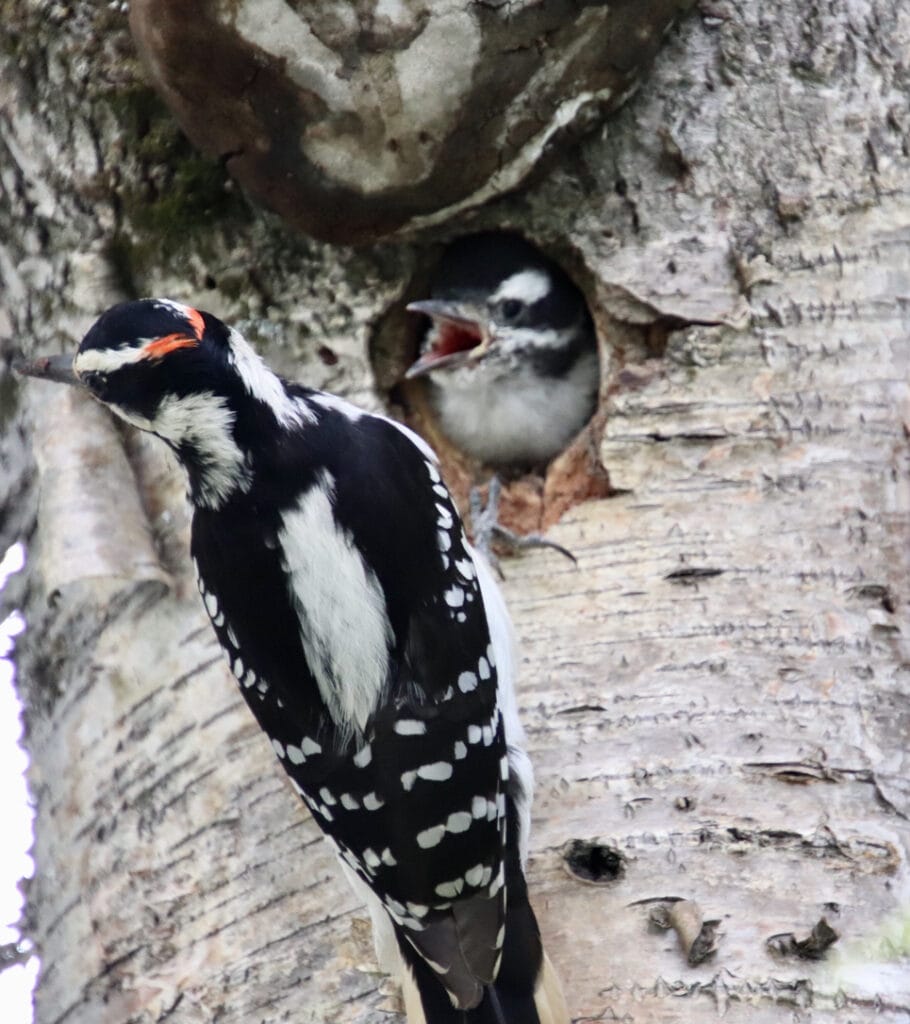
- Scientific name: Dryobates Pubescens
- Length: 5.5-6.7 inches
- Weight: 0.7-1.0 ounces
- Wingspan: 9.8-11.8 inches
What’s better to follow one of the biggest woodpeckers with? That’s right. One of the smallest!
Downy Woodpeckers are small-sized woodpeckers that are even smaller than robins. However, don’t let their small size fool you. They use their tiny bodies to forage in places that other woodpeckers can’t. Examples of those are tall weeds and plant galls.
Downy Woodpeckers look like smaller versions of the Hairy Woodpeckers (we’ll talk about those right after.)
They have a black and white checkered plumage on their tiny backs. The feathers on the throat and the belly are all white. You can differentiate between the males and females using the red patch on the back of the head of males.
If you live in Illinois, you can spot the Downy Woodpeckers at any time of the year. They love to latch on tree barks and dig holes looking for insects. Once food time is over, they go back to their nests which they form inside holes in trees.
Because of their small size, Downy Woodpeckers often join flocks of other small birds for protection. Their most common mates are nuthatches and chickadees.
Downy Woodpeckers may be small but their singing will make you recognize their presence. Their call is a mix of drumming and wavy chirping that’s very pleasant on the ears.
3. Hairy Woodpecker

- Scientific name: Dryobates Villosus
- Length: 7.1-10.2 inches
- Weight: 1.4-3.4 ounces
- Wingspan: 13.0-16.1 inches
Hairy Woodpeckers are like the older siblings of Downy Woodpeckers. They look strikingly alike and they even have similar living habits and breeding ground preferences. The red spot on the back is also restricted to the male.
Much like Downy Woodpeckers, Hairy Woodpeckers can be found during the whole year in Illinois. However, they’re not as commonly seen as the Downys.
Because of their larger size, they often require bigger trees and denser branches than Downy Woodpeckers. As a result, they’re a less common sight in parks and urban areas than Downy Woodpeckers.
Top Tip: Downy Woodpeckers are around two-thirds the size of Hairy Woodpeckers. However, that’s not enough to differentiate between them from a distance.
For better chances of knowing the difference, look for the sharper, longer bills and the straighter, more soldier-like appearance of Hairy Woodpeckers.
The diet of Hairy Woodpeckers is fairly similar to Downy Woodpeckers (and similar to most woodpeckers really.) It consists mainly of ants, beetles, and various other insects.
Hairy Woodpeckers sometimes drink the sap of trees left behind by Yellow-bellied Sapsuckers (our next woodpeckers.) Sometimes they even do their own sap sucking by pecking on sugar cane and drinking the juice.
The singing, calling, and drumming patterns of Hairy Woodpeckers are also very close to those of the Downys; the same cheerful high pitched chirps that sound like a song.
4. Yellow-bellied Sapsucker
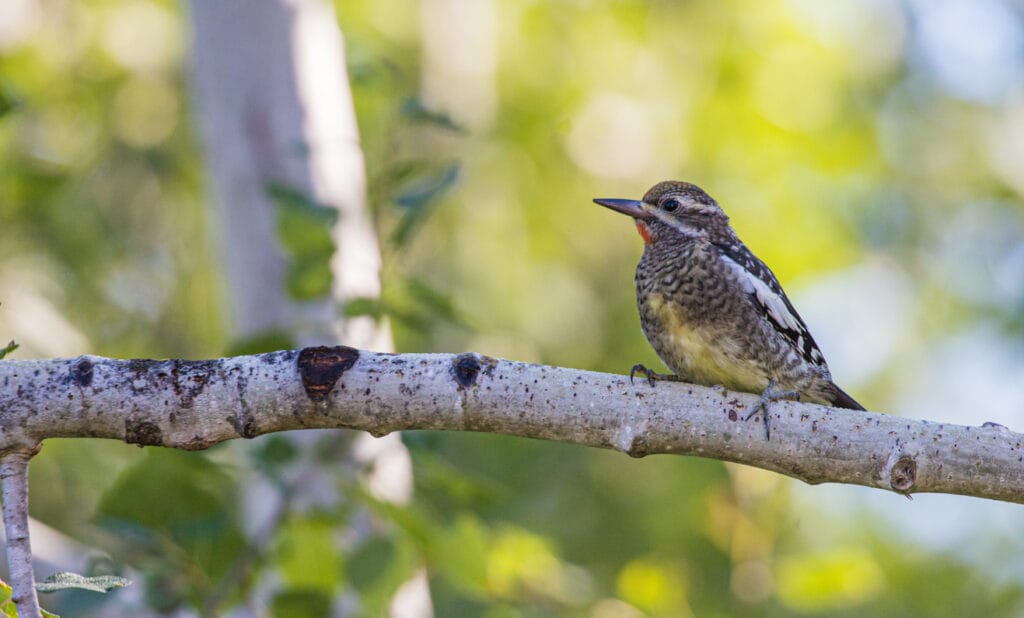
- Scientific name: Sphyrapicus Varius
- Length: 7.1-8.7 inches
- Weight: 1.5-1.9 ounces
- Wingspan: 13.4-15.8 inches
Yellow-bellied Sapsuckers are small robin-sized woodpeckers that are common to see in Illinois. However, they don’t breed there.
Their color pattern is generally black and white. Black is mostly on the back while the belly is generally white. Both genders have a beautiful red forehead and a small yellow patch on the chest. Males are easily distinguished from females by their red throats.
Unlike most of the woodpeckers on our list, Yellow-bellied Sapsuckers don’t stay all year long in Illinois. Instead, they’re often found on trees during the winter, especially in the southern parts of the state. In the northern parts, however, they are usually spotted in only the sky as they migrate.
One of the quickest ways to tell if a Yellow-bellied Sapsucker lives around is by the neatly drilled holes on tree trunks. To be able to drink the tree sap, Yellow-bellied Sapsuckers would drill several holes approximate to each other.
These holes are known as “sap wells” and they are the main source of food for Yellow-bellied Sapsuckers. In addition to the tree sap, Yellow-bellied Sapsuckers also feed on flying insects, bugs, and ants.
Ruby-throated Hummingbirds love to drink the juice from the Yellow-bellied Sapsuckers’ sap wells. In some parts of Canada, Those hummingbirds rely on those sap wells so much that they time their spring migration with the Yellow-bellied Sapsuckers.
Yellow-bellied Sapsuckers are truly unique birds but their calls make them even more special. Have you watched fantasy movies where people are shooting laser guns?
We’re not exaggerating, this is exactly what Yellow-bellied Sapsuckers sound like.
5. Red-bellied Woodpecker
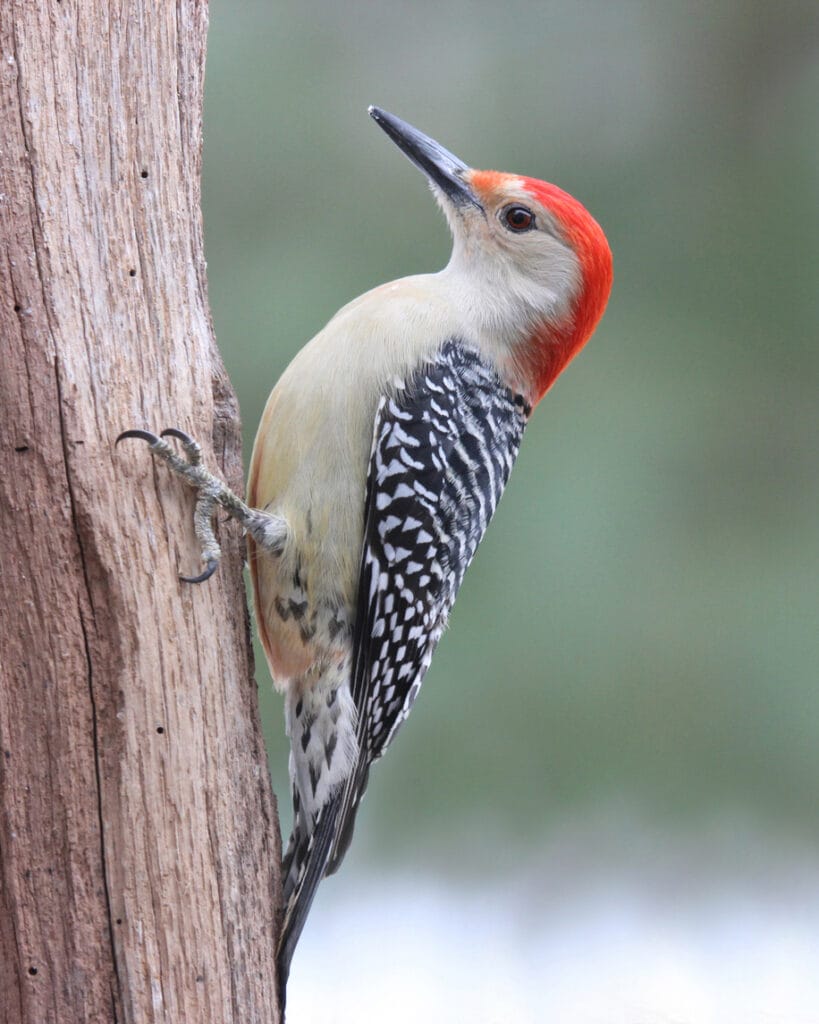
- Scientific name: Melanerpes Carolinus
- Length: 9.2-9.4 inches
- Weight: 2.0-3.2 ounces
- Wingspan: 13.0-16.5 inches
Red-bellied Woodpeckers are gorgeous-looking medium-sized birds. If you look at the picture above, you’ll notice something strange.
Despite the name, Red-bellied Woodpeckers barely have any red color in their bellies. Instead, they have a pale distribution or seemingly orange patches on some parts of their chests.
Their bellies are white for the most part and the wings are made of black and white patterns. The truly red part of Red-bellied Woodpeckers is the red line on the crown.
Males are distinguished from females using the red patch found on their cheeks which is absent in females.
Red-bellied Woodpeckers can be commonly seen at any time of the year in Illinois. They’re one of the few woodpeckers whose numbers are gradually increasing.
This is probably because of how adaptable they are. They can live in groves, forests, woodlands, and swamps.
Author Note: Red-bellied Woodpeckers are bark foragers. They like to latch to the bark of trees where they seek insects and spiders. They also eat nuts, seeds, acorns, and pine cones.
If a nut is too large for the Red-bellied Woodpecker to eat, it would wedge it between bark crevices and whack it into smaller pieces.
Unlike most woodpeckers, Red-bellied Woodpeckers don’t peck too much in search of food. Instead, they peel the tree bark off.
Red-bellied Woodpeckers have two different calls. They either make a single loud pitched noise or three small chirps with silent intervals.
Red-bellied Woodpeckers sometimes fly quickly while changing directions suddenly and abruptly. They would then land on a branch and take off again immediately to repeat the process. Scientists believe that this behavior is to train younglings in evasive actions.
6. Red-headed Woodpecker
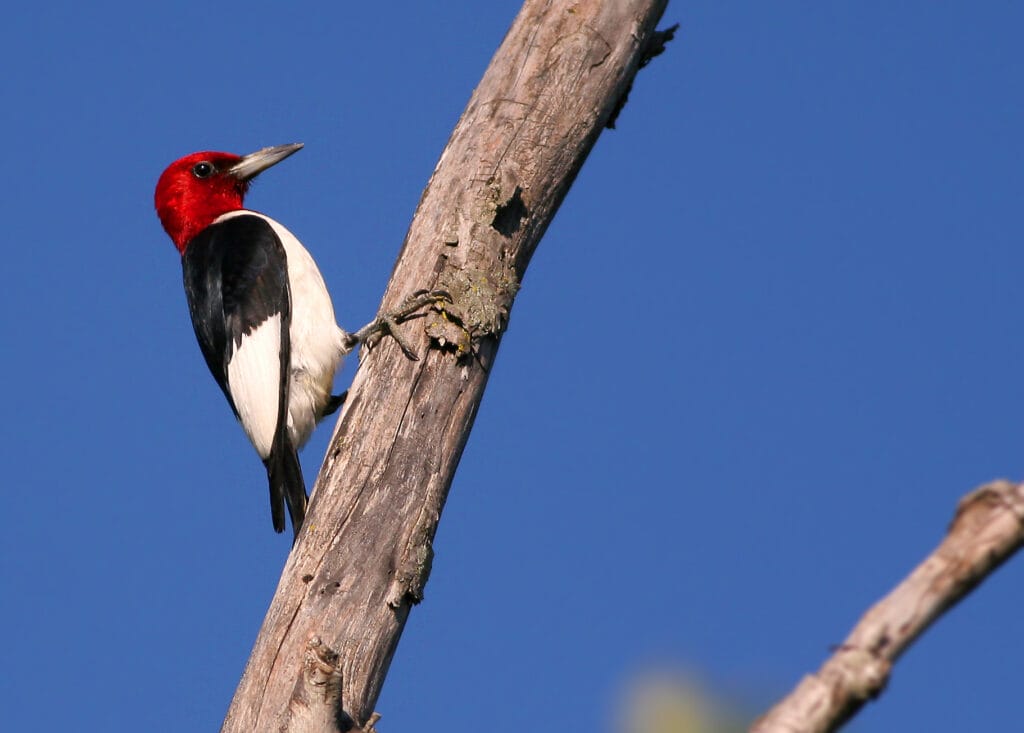
- Scientific name: Melanerpes Erythrocephalus
- Length: 7.5-9.1 inches
- Weight: 2.0-3.2 ounces
- Wingspan: 16.5 inches
Read-headed Woodpeckers are the real-life version of the cartoon character, Woody Woodpecker.
Because of how boldly patterned they are, Read-headed Woodpeckers are sometimes called the flying checkerboards.
The belly and the wing endings are white for the most part. The crown is covered with a gorgeous red color white the rest of the bird is dark blue.
Read-headed Woodpeckers can be found any time of the year in Illinois. Unfortunately, their population has been declining because of deforestation.
The cartoon Woody Woodpecker is a fan favorite but the real-life Woody isn’t as friendly. Read-headed Woodpeckers sometimes invade the nests of other birds when the parents aren’t around.
They would feed on the eggs and sometimes even eat the younglings! Because they are omnivores, they also feed on insects, nuts, and fruits.
Red-headed Woodpeckers are one of the few birds in North America that store food in their nests. Once the woodpecker finds an extra amount of food, it would carry it to its nest and cover it with tree bark to prevent other birds from reaching it.
Read-headed Woodpeckers are remarkable fliers. They sometimes wait on tree branches and look for flying insects. Once spotted, they take off suddenly and snatch the insect quickly with their bills mid-air.
7. Northern Flicker
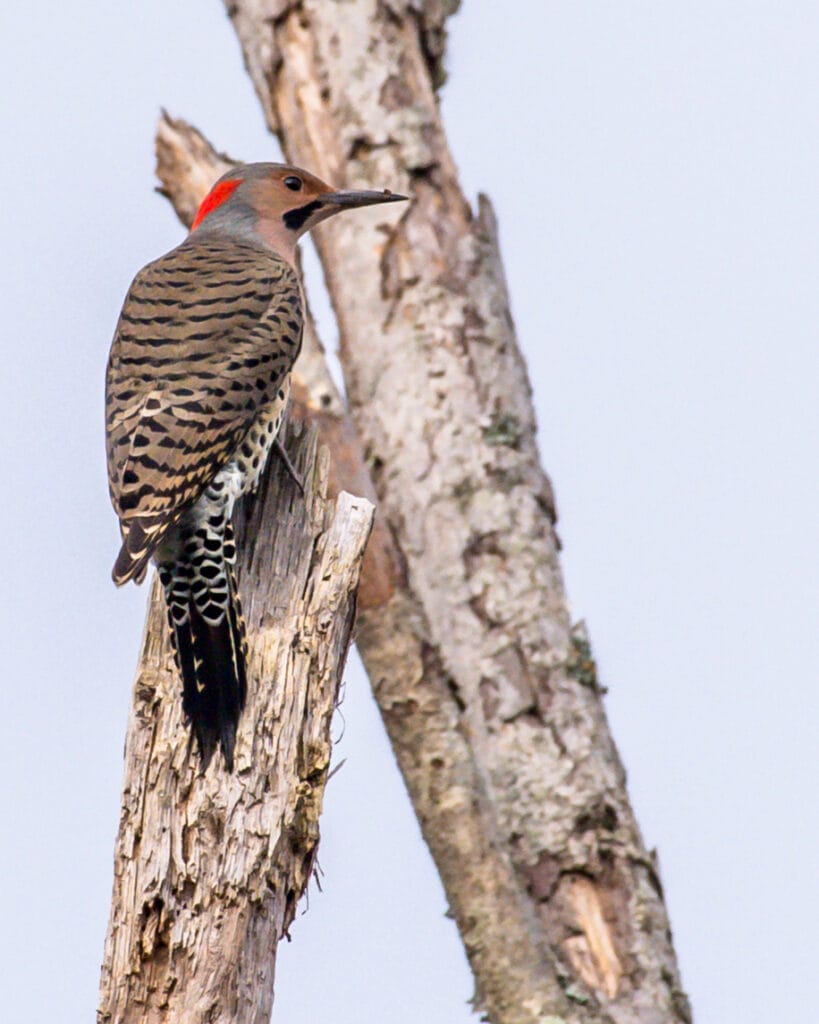
- Scientific name: Colaptes Auratus
- Length: 11.0-12.2 inches
- Weight: 3.9-5.6 ounces
- Wingspan: 16.5-20.1 inches
Northern flickers are among the most common sights not just in Illinois, but in the entirety of the United States.
Those beautiful medium-sized birds can be found at any time of the year in Illinois. Be careful when you look for them, as they’re not where you might be expecting.
Unlike the other woodpeckers on our list, Northern Flickers are ground foragers which means that they spend most of their food-seeking time on the ground. So, don’t be surprised if you accidentally scare one of them as you venture through the woods.
Northern Flickers are beautiful birds, to say the least. The plumage is a mixture between white and gray with black dots all over the body. There’s a black moon-like crest on the chest and a trident-looking red patch on the back.
Top Tip: Northern Flickers are among the fastest drumming woodpeckers out there. They’re capable of drumming at a whopping speed of 25 beats per second!
This is especially helpful for males when they seek a female. When Northern flicker males want to mate, they mix their calling with intense drumming. The female would then pick the loudest drummer to be her mate.
Check how this Northern flicker calls and drums as fast as a machine gun!
That’s a Wrap!
Those were the seven woodpeckers in Illinois. If you’d like to spot any of them, look for green areas with trees, or in your backyard if you have one.
Many woodpecker species are declining in number, so if you do run into one of them, try not to disturb its natural habitat. Consider leaving old trees in your garden as they attract some woodpeckers as well.
FAQ
Start with these places:
Illinois Beach State Park, Chautauqua National Wildlife Refuge, Dixon Waterfowl Refuge – Red-headed Woodpecker
Cache River State Natural Area – Red-headed Woodpecker, Pileated Woodpecker,
To find out where recent sightings of woodpecker have been, try eBird. You can search for the latest sightings or particular species or what has been seen in a certain area.
The Red-bellied Woodpecker is doing very well in Illinois and is probably the most common species seen there.




